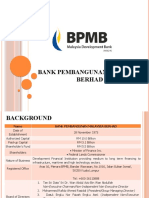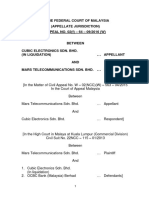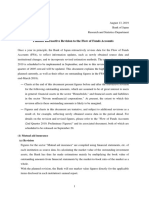Islamic Private Debt Securities
Islamic Private Debt Securities
Uploaded by
Muhammad Shahrul NazwinCopyright:
Available Formats
Islamic Private Debt Securities
Islamic Private Debt Securities
Uploaded by
Muhammad Shahrul NazwinCopyright
Available Formats
Share this document
Did you find this document useful?
Is this content inappropriate?
Copyright:
Available Formats
Islamic Private Debt Securities
Islamic Private Debt Securities
Uploaded by
Muhammad Shahrul NazwinCopyright:
Available Formats
ISLAMIC PRIVATE DEBT SECURITIES Islamic Private Debt Securities (IPDS) has been introduced since 1990.
At the moment, IDS have been introduced using different types of Syariah concept namely through Bai Bithaman Ajil, al-Musharakah, al-Mudharabah, Qardhu ul Hassan, Murabahah etc. Bai Bithaman Ajil is a contract refers to the sale of goods on a deferred payment basis. Under the concept of Bai Bithaman Ajil the financiers will purchase an asset from the borrower and later resell the assets at a higher price which contain the cost and profile element. The loan, which arises from the finance, will be securitized through the issuance of two notes that is the primary notes, which is equivalent to the asset price that is purchased by the financiers from the borrower and secondary notes which is equivalent to the profit value of the resell price. Both of these notes will be traded in the secondary market under the concept of Bai al-Dayn. Qardhul Hassan is an interest free loan given either for welfare purposes or for bridging shortterm funding requirements. Through Qardhul Hassan, the issuer of the notes will be able to arrange the repayment of the loan, which was given by the parent company. The IDS note is the evidence of debt for the amount, which is yet to be repaid. Through the IDS, the loan will be repaid by liquidating the IDS after certain period of time. The IDS is issued together with the Transferable Subscription Right (TSR). The TSR is the form of a gift (hibah) to the holder of the papers. The IDS is an alternative to the issuance of the conventional zero coupon bond.
BASIC PROCESS OF SECURITIZATION
Securitization has become a popular method of financing among corporation nowadays. Securitization is basically the process where the company pooled its illiquid assets together and issued a claim to a pool of assets. When the assets are securitised, it made the assets tradable in the financial market
From the diagram above, a securitization involves the sale of a large pool of assets by an entity or the originator that creates or purchases the assets in the course of its business to bankruptcy remote, special purpose vehicle (SPV). The SPV acts as an issuer, issue and sale the securities through either in a private placement or public offering. When securitization process is closed funds flow from the purchasers of the securities to the issuers and from the Issuers to the Originator. All these transaction occur virtually simultaneously.
The Structure
Securitization for a corporate entity involves more complicated issues. It involves three main parties, namely the Originator (i.e. the owner of the assets), the Special Purpose Vehicle (SPV) which buys the assets and issues securities and the investor (who buys the securities). Banks participate in the securitization process as originator cum servicer. Securitization enables a company to convert its assets into immediate cash, which will then determine the companys ability to going concern. It is regarded as an off-balance sheet financing whereby not only a company can convert the usable assets in to cash, but it also removes the assets (e.g. receivables) from the books.
Requirement For Assets That May Be Securitized The assets that are the subject matter of a securitization transaction must fulfill all of the following criteria:
(i) (ii)
The assets must generate cash flow; The Originator has a valid and enforceable interest in the assets and in the cash flows of the assets prior to any securitization transaction;
(iii)
There are no impediments (contractual or otherwise) that prevent the effective transfer of the assets or the rights in relation to such assets from an Originator to an SPV. For example: that the necessary regulatory or contractual consents have been obtained in order to effect the transfer of such assets from an Originator to an SPV; that the Originator has not done or omitted to do any act which enables a debtor of the Originator to exercise the right of set-off in relation to such assets;
(iv) (v)
The assets are transferred at a fair value; No trust or third partys interest appears to exist in competition with an Originators interest over the assets; and
(vi)
Where the interest of an Originator in the assets is as a chargee, the charge must have been created for a period of more than 6 months before the transfer.
Where the issue, offer or invitation of ABS are Islamic in nature, the assets that are the subject matter of the securitization transaction must be acceptable in accordance withShari'ah principles. In the event of doubt, clarification should be sought from theShari'ah Advisory Council of the SC.
ISLAMIC PRIVATE DEBT SECURITIES VS `COVENTIONAL` PRIVATE SECURITIES Islamic Private Debt Securities (IPDS) is one of the products offered in the Financial Market (Capital market) and it is among the important securities that have been playing its role efficiently. IPDS has come out from a chain of transactions that create the essence from the underlying debt, which is the subject matter of the process. In the conventional mode the debt usually generates interest, which is recognized as the riba in Islamic terms. Riba (usury) is any income generated through interest payment via lending or credit activities. Therefore, when IPDS were first created, there is a condition exists; that before a debt can be sold or negotiated, there must be an underlying contract of sale and purchase. These contracts should involving real tangible assets at the beginning of the process. The transaction cannot be just the creation from nothing. The sale and purchase contract normally contains a delayed payment element in it so that a debt is created. Then, this debt will become the intended securitization. It is just like the concept of bai al-inah. Bai al-inah allows sale and buy-back transactions so that an earlier sale of assets would produce a cheaper price compared to the price for the subsequent sale. The whole process of IPDS involves several inter-related transactions. Firstly is the normal sale and purchase contract ( al-bai). For instance, customer A sold his assets to the financier in the first transaction the sale price was RM100 million. Secondly is the buy-back transaction. This transaction occurred immediately after the first transaction where the buy-back price is at cost of RM210 million. These two contracts; the buy-back and normal sale are known as Bai al-inah. Thirdly, the payment for the buy-back transaction is delayed through the installment mechanism known in Islam as Bai B ithaman Ajil (BBA) or deferred payment. Subsequently, the debt as owed by the customer A resulting from the buy-back transaction will then be sold as securities accompanied by a certificate or note. Lastly, when this debt is sold as securities another concept is used or being applied, i.e. bai al-dayn or sale of debt. All the steps above have clarifies and portrays the differences between a conventional (bond) and an Islamic bond (security).
In the conventional sense, a bond is a debt instrument whereby the issuer will pay a certain percentage of interest to the buyer of the issued bond, or if it is a zero coupon bond, it will be issued at discount and repaid in full at maturity. Bondholders will receive the proceeds in the form of interest. In contrast, the debt created in the IPDS transaction is an unpaid purchase price owed by the customer to the financer. Such a debt is not a result of a money-lending (Islamic term: al-Qard) process as there was no such activity. Therefore from the explanation above, IPDS may be structured along Al-Bai Bithaman Ajil, AlMurabahah and Al-Bai Al-Dayn. Al-Bai Bithaman Ajil or deffered payment sale refers to the sale of goods on the differed payment basis. The financial institutions, bank for example buys assets that are requested by the customer and subsequently sells the goods to the customer at an agreed price (the sale price), which includes the banks mark up (profit). Al-Murabahah or cost-plus financing as explained in the Islamic Repo section refers to the sale of goods at price, which includes a cost-plus profit margin as agreed by both parties. Such sales contract is valid on the condition that the price, other costs and profit margin of the seller are stated at the time of the agreement sale. Lastly is the Al-Bai Al-Dayn which is refers to the debt financing that is the provision of financial resources required for the production, commerce and services by the way of sale or purchase of trade documents and papers. Only documents evidencing real debts arising from bona fide merchant transactions can be traded.
`STRUCTURE
OF ISLAMIC PRIVATE DEBT SECURITIES`
NAME: MUHAMMAD SHAHRUL NAZWIN BIN MOHD NASIR M/NO: 2010611018 CLASS: BM2224L LECTURER: MDM DATE: 10.4.2012
You might also like
- CQF CurriculumDocument21 pagesCQF Curriculumernesto123_53No ratings yet
- Financial RestructuringDocument14 pagesFinancial RestructuringKenneth InuiNo ratings yet
- Gagasan Solar Info Memo ShortDocument9 pagesGagasan Solar Info Memo ShortalagendraNo ratings yet
- Nur PowerDocument100 pagesNur Powerkim100% (1)
- Bank Pembangunan Malaysia BerhadDocument5 pagesBank Pembangunan Malaysia BerhadkinNo ratings yet
- 18-O-1480 - Exhibit 3 - DDA - Gulch (EZ Bonds) - Draw-Down Bond Purchase AgreementDocument32 pages18-O-1480 - Exhibit 3 - DDA - Gulch (EZ Bonds) - Draw-Down Bond Purchase AgreementmaggieleeNo ratings yet
- Credit Risk Issue in Partnership Contract The Case of MusyarakahDocument28 pagesCredit Risk Issue in Partnership Contract The Case of MusyarakahhisyamstarkNo ratings yet
- FOF Tutorial 9 AnsDocument6 pagesFOF Tutorial 9 AnsYasmin Zainuddin100% (1)
- Green Bond Methodology 2017Document5 pagesGreen Bond Methodology 2017Prince PoddarNo ratings yet
- IIFM Sukuk Report (3rd Edition) A Comprehensive Study of The Global Sukuk MarketDocument86 pagesIIFM Sukuk Report (3rd Edition) A Comprehensive Study of The Global Sukuk MarketririnkhairaniNo ratings yet
- Maybank SukukDocument46 pagesMaybank SukuksydanznNo ratings yet
- CX Renewables Solar Bond Offer 6mDocument55 pagesCX Renewables Solar Bond Offer 6mAnonymous pEfXMJ8QNo ratings yet
- Mydin IM PDFDocument108 pagesMydin IM PDFOilandGas IndependentProjectNo ratings yet
- Asia Local Markets Guide 2012Document177 pagesAsia Local Markets Guide 2012kanika202No ratings yet
- 5-Valuation of BondsDocument52 pages5-Valuation of BondsAkansh NuwalNo ratings yet
- 42 Biomass-Based Power Generation and Cogeneration in Palm Oil Industry Ph1 Malaysia - Final EvaluationDocument58 pages42 Biomass-Based Power Generation and Cogeneration in Palm Oil Industry Ph1 Malaysia - Final EvaluationAnuj ShresthaNo ratings yet
- Syndicated Term Loan Agreement - Vetting SessionDocument86 pagesSyndicated Term Loan Agreement - Vetting SessionYash MayekarNo ratings yet
- Bank Rakyat Law CaseDocument17 pagesBank Rakyat Law CaseDeena YosNo ratings yet
- Mahyuddin Khalid Emkay@salam - Uitm.edu - MyDocument19 pagesMahyuddin Khalid Emkay@salam - Uitm.edu - MyZatil AqmarNo ratings yet
- Compulsory Convertible Debentures and Optionally Fully-Convertible DebenturesDocument7 pagesCompulsory Convertible Debentures and Optionally Fully-Convertible DebenturesBeerappa RamakrishnaNo ratings yet
- RANK Group ProfileDocument16 pagesRANK Group ProfileRupeshNo ratings yet
- I-REC - Standard Terms and Conditions - UAE-dubaiDocument12 pagesI-REC - Standard Terms and Conditions - UAE-dubailuxusNo ratings yet
- Islamic Banking in QatarDocument25 pagesIslamic Banking in QatarNkanissa MohdNo ratings yet
- Putrajaya Sukuk - PTCDocument33 pagesPutrajaya Sukuk - PTCYEW OI THIMNo ratings yet
- Bond Market Maths: Group Members Swarana Biyani - 01 Sanket Desai - 02 Rohan Jadhav - 08 Shama Lonare - 14Document74 pagesBond Market Maths: Group Members Swarana Biyani - 01 Sanket Desai - 02 Rohan Jadhav - 08 Shama Lonare - 14Namrata KolteNo ratings yet
- Private PlacementDocument7 pagesPrivate PlacementRajeshwary CoolNo ratings yet
- L8 - Green BondDocument36 pagesL8 - Green BondCLNo ratings yet
- SEBI AIF RegulationsDocument79 pagesSEBI AIF RegulationsAjay RottiNo ratings yet
- DIFC Special Purpose Company Regulations (2) 0Document19 pagesDIFC Special Purpose Company Regulations (2) 0tosesNo ratings yet
- CIMB Bank BHD V Maybank Trustees BHD and Other Appeals (2014) 3 MLJ 169Document59 pagesCIMB Bank BHD V Maybank Trustees BHD and Other Appeals (2014) 3 MLJ 169Cal VinNo ratings yet
- PTRANS Share Buy Back StatementDocument16 pagesPTRANS Share Buy Back Statementseeme55runNo ratings yet
- Equity and DebtDocument30 pagesEquity and DebtsandyNo ratings yet
- Quantum Solar - Information MemorandumDocument279 pagesQuantum Solar - Information MemorandumMohamad EzarinNo ratings yet
- Islamic Banking AssignmentDocument7 pagesIslamic Banking AssignmentFarjad AliNo ratings yet
- Financial Modeling NotesDocument10 pagesFinancial Modeling NotesAna Alejandra GarciaNo ratings yet
- Sovereign Guarantee: Welcome To Presentation OnDocument7 pagesSovereign Guarantee: Welcome To Presentation OnMohammad Zahirul IslamNo ratings yet
- SEBI and Primary MarketDocument7 pagesSEBI and Primary Marketशुभम डिमरीNo ratings yet
- All Chapter QuizDocument32 pagesAll Chapter QuizRebecaNo ratings yet
- Sweat Equity Shares Under Companies Act 2013Document2 pagesSweat Equity Shares Under Companies Act 2013Ritika SharmaNo ratings yet
- 1.history of BankingDocument15 pages1.history of Bankinganon_353612519100% (1)
- Innovations in Green Credit Markets (Working Paper) - Esohe Denise Odaro, Head of Investor Relations IFCDocument19 pagesInnovations in Green Credit Markets (Working Paper) - Esohe Denise Odaro, Head of Investor Relations IFCedo7No ratings yet
- SCFS23 Day 2 - Full Day SlidesDocument109 pagesSCFS23 Day 2 - Full Day SlidesJoaquin DuranyNo ratings yet
- IFRS 9 - Financial InstrumentsDocument37 pagesIFRS 9 - Financial InstrumentslaaybaNo ratings yet
- Eco 531 - Chapter 3Document22 pagesEco 531 - Chapter 3Nurul Aina IzzatiNo ratings yet
- Islamic Real Estate Investment Trust As An Investment Asset For Waqf Management in Indonesia: Regulatory Framework and Shariah-CompliancyDocument45 pagesIslamic Real Estate Investment Trust As An Investment Asset For Waqf Management in Indonesia: Regulatory Framework and Shariah-CompliancyYoga PrakasaNo ratings yet
- Venture DebtDocument2 pagesVenture Debtmanoj yadavNo ratings yet
- SPA SampleDocument38 pagesSPA SampleRendy Montague100% (1)
- Top 3 SEBI Orders Under The Takeover Code in The Year 2017Document11 pagesTop 3 SEBI Orders Under The Takeover Code in The Year 2017dhruv vashisthNo ratings yet
- 1.0 Bank and Banking BusinessDocument18 pages1.0 Bank and Banking BusinessAidil RizalNo ratings yet
- Buku Financing Development in IslamDocument411 pagesBuku Financing Development in IslamadnidwiastutiNo ratings yet
- Application of Funds - Financing Facilities and The Underlying Shariah ConceptsDocument40 pagesApplication of Funds - Financing Facilities and The Underlying Shariah ConceptsMahyuddin Khalid100% (2)
- MudharabahDocument17 pagesMudharabahShyla92No ratings yet
- Session. 25. Letters of Credit and Bank GuaranteesDocument30 pagesSession. 25. Letters of Credit and Bank GuaranteesHemant KawalkarNo ratings yet
- Cubic Electronics V Mars Telecommunication - JDocument70 pagesCubic Electronics V Mars Telecommunication - JFyruz100% (1)
- The 1malaysia Development Berhad (1MDB) Scandal - Exploring Malays.Document55 pagesThe 1malaysia Development Berhad (1MDB) Scandal - Exploring Malays.yuszriNo ratings yet
- Principal Adviser Principal Adviser Principal Adviser Principal Adviser Principal AdviserDocument74 pagesPrincipal Adviser Principal Adviser Principal Adviser Principal Adviser Principal AdviserCheong Wei HaoNo ratings yet
- Valuation of SharesDocument9 pagesValuation of Sharesshalini0703No ratings yet
- Basic Concepts of Islamic FinanceDocument5 pagesBasic Concepts of Islamic FinanceSaifullahMakenNo ratings yet
- Islamic BankingDocument5 pagesIslamic BankingAtif KhanNo ratings yet
- Sana Islamic LawDocument7 pagesSana Islamic LawArslan MalikNo ratings yet
- Securitisation An Overview: H HE EM ME EDocument8 pagesSecuritisation An Overview: H HE EM ME Ejlo42No ratings yet
- Cypher - Steam - Trading - History - and - Investing - UPDDocument28 pagesCypher - Steam - Trading - History - and - Investing - UPDNuri AydogduNo ratings yet
- Bank Reconciliation StatementDocument50 pagesBank Reconciliation StatementwubeNo ratings yet
- Introduction of PartnershipDocument1 pageIntroduction of Partnershipmrn69092No ratings yet
- Real Estate and Destination Development in TourismDocument331 pagesReal Estate and Destination Development in Tourismfarah fadillahNo ratings yet
- Planned Retroactive Revision To The Flow of Funds Accounts: (1) Mutual Aid Insurance (A) RevisionDocument10 pagesPlanned Retroactive Revision To The Flow of Funds Accounts: (1) Mutual Aid Insurance (A) RevisionedgarmerchanNo ratings yet
- Module 4-CoC-1Document13 pagesModule 4-CoC-1Abida RiazNo ratings yet
- CHAPTER 19 & 20 Earnings Per ShareDocument15 pagesCHAPTER 19 & 20 Earnings Per Sharepapa1No ratings yet
- Stock Market QuizDocument5 pagesStock Market QuizRavi KiranNo ratings yet
- BFD Merged Q Tahapopatia +923453086312Document96 pagesBFD Merged Q Tahapopatia +923453086312Abdul BasitNo ratings yet
- Exercise C4Document6 pagesExercise C4Bruno Estanque ViegasNo ratings yet
- Reviewer Quiz 4Document21 pagesReviewer Quiz 4Jessica Mikah Lim AgbayaniNo ratings yet
- Prelim ExamDocument40 pagesPrelim ExamAbegail RafolsNo ratings yet
- Banking Class 12Document12 pagesBanking Class 12pratikmalu3No ratings yet
- BUSINESS PLAN 2009-2011 LOTHO HK (Sunglasses Brand)Document8 pagesBUSINESS PLAN 2009-2011 LOTHO HK (Sunglasses Brand)Sebastien MorinNo ratings yet
- Assignment: On Financial Statement Analysis and ValuationDocument6 pagesAssignment: On Financial Statement Analysis and ValuationMd Ohidur RahmanNo ratings yet
- Interest Rate Swap DiagramDocument1 pageInterest Rate Swap DiagramTheGreatDealerNo ratings yet
- Presentation of Business Finance 2Document10 pagesPresentation of Business Finance 2Affan AhmedNo ratings yet
- Off White and Black SWOT Analysis ChartDocument1 pageOff White and Black SWOT Analysis ChartutNo ratings yet
- Balance Sheet As at 31 March 2017 Note No. (Rs. in Crores) Assets Non-Current AssetsDocument4 pagesBalance Sheet As at 31 March 2017 Note No. (Rs. in Crores) Assets Non-Current AssetssaurabhsarafNo ratings yet
- Cost 5Document12 pagesCost 5NesriaNo ratings yet
- KPMG Course of Accounting Professional: An Integrated Learning Program For Upcoming Finance ProfessionalsDocument114 pagesKPMG Course of Accounting Professional: An Integrated Learning Program For Upcoming Finance ProfessionalsKrishna ShahNo ratings yet
- SI and CI - Manas-1Document27 pagesSI and CI - Manas-1Shreya JoriNo ratings yet
- ERXGen BreakOut MultiCurrency TraderDocument2 pagesERXGen BreakOut MultiCurrency TradercocoNo ratings yet
- Estimation of Project Cash Flows: RequiredDocument4 pagesEstimation of Project Cash Flows: Requiredjjayakumar_vjNo ratings yet
- Itc ValuationDocument31 pagesItc ValuationPrabhdeep DadyalNo ratings yet
- (PRELIM) BSA-3106 - International-AccountingDocument12 pages(PRELIM) BSA-3106 - International-AccountingKholette ValeNo ratings yet
- Economics Paper 1 Marking Guide 2022Document8 pagesEconomics Paper 1 Marking Guide 2022btitiemmyrevNo ratings yet
- Glossary Sovereign Nonsovereign Operations 2022Document8 pagesGlossary Sovereign Nonsovereign Operations 2022JamesNo ratings yet
- 2013 Nestle Q4 2012 Media Release enDocument4 pages2013 Nestle Q4 2012 Media Release enronalzdinNo ratings yet

























































































